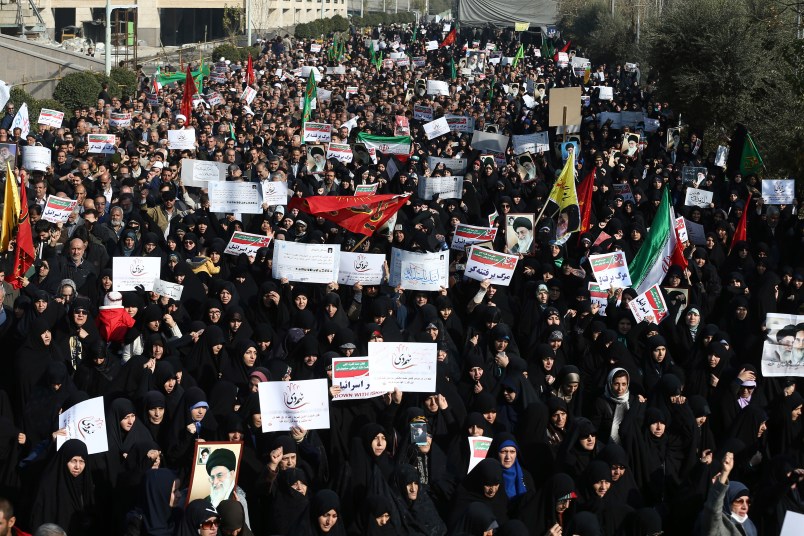TEHRAN, Iran (AP) — Iranian state media on Wednesday aired pro-government demonstrations in cities across the country after a week of protests and unrest over the nation’s poor economy — a move apparently seeking to calm nerves amid clashes that have killed 21 people.
The protests, the largest seen in Iran since its disputed 2009 presidential election, began Dec. 28 in the city of Mashhad, Iran’s second-largest, over the weak economy and a jump in food prices. They have since expanded to cities and towns in nearly every province. Hundreds have been arrested, and a prominent judge warned that some could face the death penalty.
The English-language broadcaster Press TV broadcast Wednesday’s pro-government rallies live, saying they were to “protest the violence that has taken place over the last few nights in cities.”
Demonstrators waved Iranians flags and signs supporting Iran’s clerically overseen government.
According to state TV, the demonstrations took place in at least 10 cities, including Ahvaz, the capital of the oil-rich province of Khuzestan, the Kurdish town of Kermanshah in the country’s west and Qom, the religions capital of Shiite Islam in Iran.
The rallies come after Iran’s Supreme Leader Ayatollah Ali Khamenei on Tuesday blamed days of protests across the country on meddling by “enemies of Iran.”
“Look at the recent days’ incidents,” Khamenei said. “All those who are at odds with the Islamic Republic have utilized various means, including money, weapons, politics and (the) intelligence apparatus, to create problems for the Islamic system, the Islamic Republic and the Islamic Revolution.”
Khamenei avoided identifying any foreign countries, although he promised to elaborate in the coming days. Undoubtedly high on his list is the United States, where President Donald Trump has tweeted his support for the protests for several days.
Iran’s government has since shut down access to Telegram and the photo-sharing app Instagram, which now join Facebook and Twitter in being banned, in an attempt to slow the unrest.
The Trump administration called on Iran’s government to stop blocking Instagram and other popular social media sites. U.S. Undersecretary of State Steve Goldstein said Instagram, Telegram and other platforms are “legitimate avenues for communication.”
The head of Tehran’s Revolutionary Court also reportedly warned that arrested protesters could potentially face the death penalty.
“Obviously one of their charges can be Moharebeh,” or waging war against God, Iran’s semi-official Tasnim news agency quoted Mousa Ghazanfarabadi as saying. Moharebeh is punishable by death in Iran.
___
Gambrell reported from Dubai, United Arab Emirates.







If the best the Ayatollah can do is threaten people with death and blame external enemies he’s headed for a historical slot next to Louis XVI and King John. Iran’s been on simmer for 20 years. Each time it’s people turn up the heat the Clerics quash it with an overdose of what the people are hot about. I doubt the Iranian’s will haul their Ayatollahs to the Place de la Concorde but some form of Magna Carta is coming.